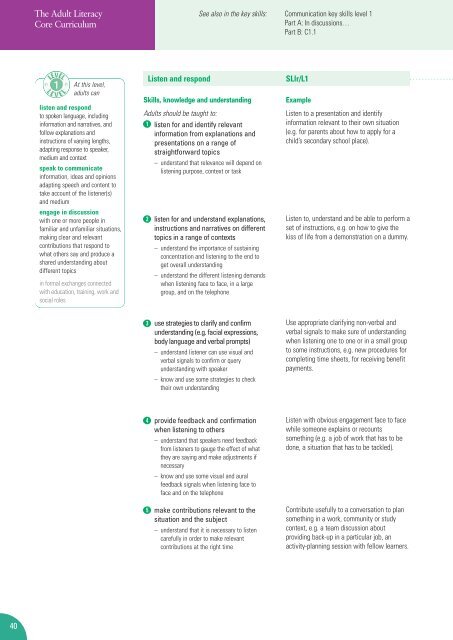Adult Literacy Core Curriculum - Nationally developed Skills for Life ...
Adult Literacy Core Curriculum - Nationally developed Skills for Life ...
Adult Literacy Core Curriculum - Nationally developed Skills for Life ...
You also want an ePaper? Increase the reach of your titles
YUMPU automatically turns print PDFs into web optimized ePapers that Google loves.
40<br />
The <strong>Adult</strong> <strong>Literacy</strong><br />
<strong>Core</strong> <strong>Curriculum</strong><br />
At this level,<br />
adults can<br />
listen and respond<br />
to spoken language, including<br />
in<strong>for</strong>mation and narratives, and<br />
follow explanations and<br />
instructions of varying lengths,<br />
adapting response to speaker,<br />
medium and context<br />
speak to communicate<br />
in<strong>for</strong>mation, ideas and opinions<br />
adapting speech and content to<br />
take account of the listener(s)<br />
and medium<br />
engage in discussion<br />
with one or more people in<br />
familiar and unfamiliar situations,<br />
making clear and relevant<br />
contributions that respond to<br />
what others say and produce a<br />
shared understanding about<br />
different topics<br />
in <strong>for</strong>mal exchanges connected<br />
with education, training, work and<br />
social roles<br />
<strong>Skills</strong>, knowledge and understanding<br />
<strong>Adult</strong>s should be taught to:<br />
1 listen <strong>for</strong> and identify relevant<br />
in<strong>for</strong>mation from explanations and<br />
presentations on a range of<br />
straight<strong>for</strong>ward topics<br />
– understand that relevance will depend on<br />
listening purpose, context or task<br />
2<br />
3<br />
4<br />
5<br />
See also in the key skills: Communication key skills level 1<br />
Part A: In discussions. . .<br />
Part B: C1.1<br />
Listen and respond SLlr/L1<br />
listen <strong>for</strong> and understand explanations,<br />
instructions and narratives on different<br />
topics in a range of contexts<br />
– understand the importance of sustaining<br />
concentration and listening to the end to<br />
get overall understanding<br />
– understand the different listening demands<br />
when listening face to face, in a large<br />
group, and on the telephone<br />
use strategies to clarify and confirm<br />
understanding (e.g. facial expressions,<br />
body language and verbal prompts)<br />
– understand listener can use visual and<br />
verbal signals to confirm or query<br />
understanding with speaker<br />
– know and use some strategies to check<br />
their own understanding<br />
provide feedback and confirmation<br />
when listening to others<br />
– understand that speakers need feedback<br />
from listeners to gauge the effect of what<br />
they are saying and make adjustments if<br />
necessary<br />
– know and use some visual and aural<br />
feedback signals when listening face to<br />
face and on the telephone<br />
make contributions relevant to the<br />
situation and the subject<br />
– understand that it is necessary to listen<br />
carefully in order to make relevant<br />
contributions at the right time<br />
Example<br />
Listen to a presentation and identify<br />
in<strong>for</strong>mation relevant to their own situation<br />
(e.g. <strong>for</strong> parents about how to apply <strong>for</strong> a<br />
child’s secondary school place).<br />
Listen to, understand and be able to per<strong>for</strong>m a<br />
set of instructions, e.g. on how to give the<br />
kiss of life from a demonstration on a dummy.<br />
Use appropriate clarifying non-verbal and<br />
verbal signals to make sure of understanding<br />
when listening one to one or in a small group<br />
to some instructions, e.g. new procedures <strong>for</strong><br />
completing time sheets, <strong>for</strong> receiving benefit<br />
payments.<br />
Listen with obvious engagement face to face<br />
while someone explains or recounts<br />
something (e.g. a job of work that has to be<br />
done, a situation that has to be tackled).<br />
Contribute usefully to a conversation to plan<br />
something in a work, community or study<br />
context, e.g. a team discussion about<br />
providing back-up in a particular job, an<br />
activity-planning session with fellow learners.

















